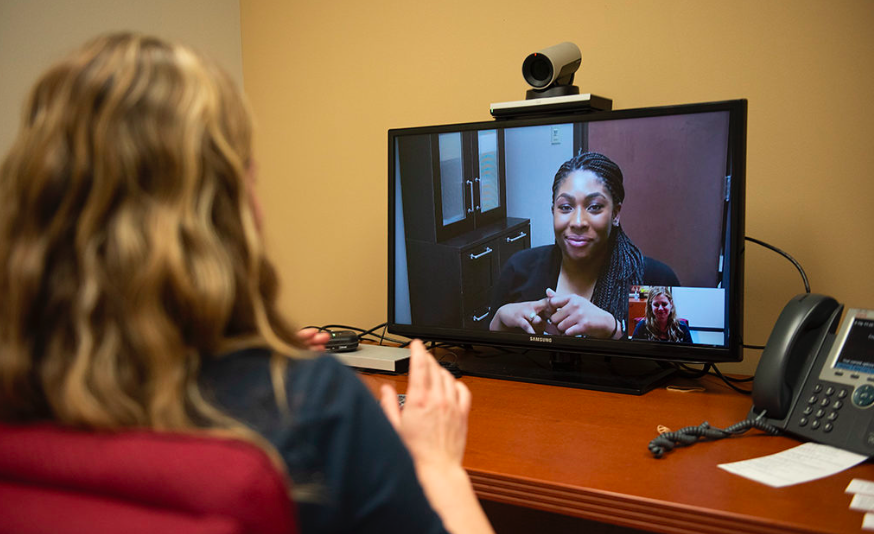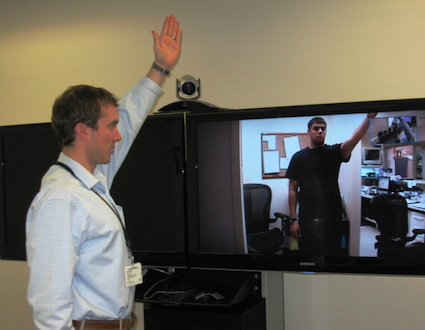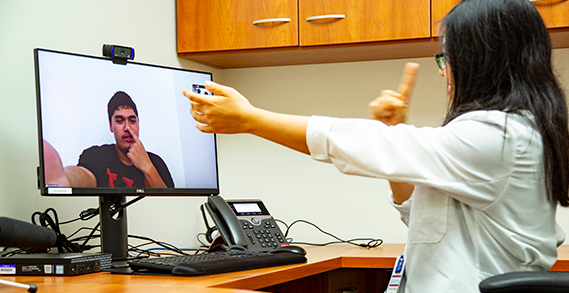|
While some of us have grown up with one hand on the computer mouse and a smartphone in the other, others have more gradually learned to love the virtual world and all the convenience that it offers. Some, like my dear husband, a bit more reluctantly bring up the rear, but for all of us, the virtual world offers both well known, and as yet undiscovered, opportunities. One of these opportunities is called Telehealth. It may also be referred to as Telemedicine or Telerehabilitation. Whatever the term, what it entails is, simply, connecting with your healthcare provider over the internet, usually through video, instead of in a common physical space. Telemedicine has already been in use for several years by everyone from mental health practitioners to medical doctors, but the recent virus outbreak and the subsequent social distancing efforts have catapulted it into our awareness. Thanks to Telehealth, patients, ranging from children with special needs to adults of all ages with musculoskeletal complaints, pain, weakness or balance problems, have been able to continue to receive the care that they need. Telehealth has enabled patients to prevent the worsening of chronic pain, and the loss of balance and function, that a long break in their care otherwise might have caused. Private insurers have fast-forwarded the inclusion of Telehealth into services that they cover, United Healthcare Medicare Advantage just joined the insurers that cover Telehealth, and traditional Medicare may, hopefully, not be far behind. To many prospective patients Telehealth is still a new option. What follows is a list of frequently asked questions, to help you get acquainted with what awaits at the most recent frontier of healthcare, and how you can benefit now. Why should I use Telehealth instead of being seen in a physical therapy office? At this time, one of the benefits is more obvious than ever. Telehealth offers therapy without the need to leave your home, and the recent stay-at-home order, while not preventing physical therapy in a physical office, has made many choose the stay-at-home therapy option. There are many other reasons for having therapy at home. Convenience, saving time, avoiding a difficult or tiring commute are reasons many patients share. Does Telehealth have any distinct and unique benefits? Since a Telehealth session doesn’t require you to leave your home is is a lot easier to fit a physical therapy session into your day. Telehealth brings the therapist into your home and enables her or him to make concrete suggestions for improving your work station, chairs you spend a lot of time in, your workout space etc. If a personal trainer comes into your home on a regular basis, or if you work out at home, you can use a Telehealth session to have your physical therapist review your workout in real time, and make sure it is safe and appropriate, and make suggestions for improvement. Home exercises are reviewed in the actual environment where you are performing them, as opposed to in the therapists office. It may also be easier for a loved one, or other person assisting you, to be present.  So how does a Telehealth session happen? Telehealth sessions are scheduled in exactly the same way that other sessions are, directly with the therapist, or online. You then receive a confirmation email with a linkto a HIPAA compliant, secure website with the simplest program imaginable, called doxy.me . The website works like this: at the time of your appointment you simply click a on link you’ve been given when scheduling a session. (You can click the link here to enter my virtual clinic right now if you like, just to see what it looks like). During the appointment, you may sit in front of your computer to chat with the therapist, and angle the camera of your laptop or smartphone, or stand in front of your desktop computer, so that the therapist can see you, examine you and direct you through exercises.  __________________________________________________________________________________________________ CLICK HERE FOR SIMPLE INSTRUCTIONS FOR YOUR PHYSICAL THERAPY TELEHEALTH SESSION. ___________________________________________________________________________________________________________ Is Telehealth covered by insurance? The good news is that Telehealth is covered by many insurers. Blue Cross and Blue Shield state on their website that they cover these services, and United Healthcare Medicare Advantage plans just announced that they cover Telehealth services as well. Traditional Medicare will hopefully follow suit. As always, it’s a good idea to call your insurance company and ask them directly about Telehealth services (note: traditional Medicare covers something they call e-visit, which is simply a phone call, and is not to be confused with Telehealth). Telehealth services can, like all other services, also be accessed on a self-pay basis. In response to the financial uncertainty many are currently experiencing I am offering pro-rated half hour Telehealth services as well. These shorter appointments are only available to established patients. Can Telehealth appointments be used in conjunction with physical appointments? This may actually be one of the best ways to use Telehealth services. After the initial appointment a patient may not need to be seen in a physical office for every visit, and can effortlessly connect with their therapist from home, their office or while traveling. However, from time to time the patient may have an issue that ideally would be dealt with in person, eg when a manual treatment technique is indicated. If you can click on a link, you can use Telehealth. I’m not very technologically savvy. What happens if I schedule a Telehealth appointment and can’t figure it out? If you can click on a link, you can use Telehealth. The program is extremely simple, and there are just a couple of very simple prompts to follow. That said, if you experience some difficulties with your computer, your internet or any other related issue, don’t worry, we’ll just try again later. You won’t be on the hook for an appointment you showed up for, but couldn’t benefit from because some technical difficulty got in the way. I have my home exercises. Won’t that be enough? Performing a set of home exercises that you were once given is almost never enough in the long run to give you the benefits of physical therapy: avoiding and decreasing pain, ensuring improved and continued function, avoiding injuries and falls, optimizing health, and ensuring that you don’t lose it. Human function is quite complex, and simply performing three or four exercises and expecting them to carry over into your functional movements, your everyday life, is not quite realistic. Due to the complexity of our wonderful, adaptable bodies, that nevertheless remain vulnerable to the challenges of our modern lifestyles, it is simply not possible to teach a patient everything that is needed to meet the challenge of becoming and staying healthy during a few encounters. This is why Physical Therapy is traditionally delivered as a long, or shorter, series of appointments, that build on one another, as understanding increases and function improves, and is often supplemented by less frequent visits as function has been recovered, to keep you on the right track and address smaller difficulties along the way. Home exercises tend to, without supervision and correction, morph into something less effective over time. The patient’s ability and skill grows, and exercises need to be progressed. New symptoms may appear, and need to be addressed, the patient needs to gradually learn how to apply their growing stability, strength or range of motion to their everyday activities, and, speaking of every day: every day tends to bring new challenges, new movements: a trip, lifting visiting grandchildren, a race you’re training for, a new job, a new hobby. As you work your way out of an injury and back to full function, you will need help modulating your activity level —“does this ache mean stop or that I’m getting stronger?” Life is ever changing and fluctuating, and our response needs to mimic that. If you are new to Telehealth, you will be surprised how easy and natural it soon feels! How can I use Telemedicine? How will I know if it will work for my needs? I am, as always, here to answer any questions you may have! Email me, text me (847-208-8063) or call me, or simply schedule an appointment now.
14 Comments
4/15/2021 03:18:36 pm
I like that this post shared with us that when choosing a telehealth service, it is important for us to consider service quality. The other day my friend mentioned that she is looking to get in touch with a telehealth service provider. I will look into reliable services to recommend her.
Reply
Isabella Lucas
11/11/2022 02:23:28 pm
My ex-husband and I had always managed to stay friendly after our divorce in February 2017. But I always wanted to get back together with him, All it took was a visit to this spell casters website last December, because my dream was to start a new year with my husband, and live happily with him.. This spell caster requested a specific love spell for me and my husband, and I accepted it. And this powerful spell caster began to work his magic. And 48 hours after this spell caster worked for me, my husband called me back for us to be together again, and he was remorseful for all his wrong deeds. My spell is working because guess what: My “husband” is back and we are making preparations on how to go to court and withdraw our divorce papers ASAP. This is nothing short of a miracle. Thank you Dr Emu for your powerful spells. Words are not enough.
Reply
5/7/2021 11:16:54 am
For the past few months, my niece has been begging her mom to let her join a soccer team this summer. I like that you mention that you have a series of appointments for physical therapy so that they can all build on each other, rather than just having a single meeting. Maybe my sister should look into a physical therapy service in case she gets injured or to help her build up her strength so she can enjoy the sport.
Reply
5/18/2021 09:41:00 pm
I appreciated it when you shared that most patients with medical health conditions are able to receive treatments via telemedicine. My friend just mentioned the other day that she is worried about her mother who refused to go to the hospital as she is unable to walk by herself as she can't walk properly due to her old age. I will suggest to her looking for a reliable healthcare facility that can offer telemedicine for her mother so she can receive advice from doctors.
Reply
7/30/2021 10:19:14 am
It's good to know that home exercises are almost never enough. I was going to do that. But now I'll find a physiotherapist to help me recover.
Reply
9/23/2021 04:47:54 pm
It's good to know that you won't have to leave your home. My sister is needing to get physical therapy. I'll make sure to pass this information along to her so that she can know the advantages of telehealth physical therapy.
Reply
10/18/2021 02:11:36 am
Really Like These New Tips, Which I Haven't Heard of Before, Like What is Functional Medicine? Can’t Wait to Implement Some of These as Soon as Possible.
Reply
Dexter Tamara
5/30/2022 12:32:23 pm
Reply
7/14/2022 06:45:42 pm
I love that you talked that from practitioners and doctors, telemedicine have been used many years ago. My brother told me the other night that his friend was having issues with his gender identity, and he asked if I had any idea what would be the best option to explore feelings. Thanks to this enlightening article, I'll be sure to give him the advice that consulting telehealth therapy service can help provide more information about the treatment process.
Reply
Jred Hatty
8/3/2022 03:39:56 pm
I TESTED POSITIVE FOR HSV-2 A FEW MONTHS AGO.
Reply
Jason Bennett
10/31/2022 08:48:27 pm
Omg I Finally Got Helped !! I'm so excited right now, I just have to share my testimony on this Forum.. The feeling of being loved takes away so much burden from our shoulders. I had all this but I made a big mistake when I cheated on my wife with another woman and my wife left me for over 4 months after she found out.. I was lonely, sad and devastated. Luckily I was directed to a very powerful spell caster Dr Emu who helped me cast a spell of reconciliation on our Relationship and he brought back my wife and now she loves me far more than ever.. I'm so happy with life now. Thank you so much Dr Emu, kindly Contact Dr Emu Today and get any kind of help you want.. Via Email [email protected] or Call/WhatsApp cell number +2347012841542
Reply
11/2/2022 06:51:30 am
It is good to know that the recent virus outbreak made telehealth widely used. My friend wants to receive therapy at home. I think it's best for her to opt for a telehealth therapy appointment so she doesn't have to leave home.
Reply
11/23/2022 02:01:28 am
Thank you for pointing out that, while the recent stay-at-home order does not preclude physical therapy in a physical office, it has led many people to pick the stay-at-home therapy option. My friend is under a lot of stress as a result of work-related trauma. I will look for anxiety telehealth services to assist her in overcoming her anxiety.
Reply
12/16/2022 03:38:21 pm
We loved what you explained about opting for telehealth to avoid needing to drive long distances to catch your appointment. My cousin got injured in a car accident a few weeks ago, and he just started his physical therapy, so since he lives away from the city, I believe he'd benefit from reading your piece. I appreciate your advice on how telehealth is a time-saving option for your treatment.
Reply
Your comment will be posted after it is approved.
Leave a Reply. |
Archives
February 2024
|




 RSS Feed
RSS Feed